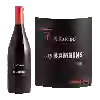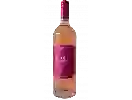
Winery Abbaye de ValmagneCuvée Bernard et Benoit Rouge
In the mouth this red wine is a powerful with a nice balance between acidity and tannins.
This wine generally goes well with beef, veal or pasta.
Taste structure of the Cuvée Bernard et Benoit Rouge from the Winery Abbaye de Valmagne
Light | Bold | |
Smooth | Tannic | |
Dry | Sweet | |
Soft | Acidic |
In the mouth the Cuvée Bernard et Benoit Rouge of Winery Abbaye de Valmagne in the region of Languedoc-Roussillon is a powerful with a nice balance between acidity and tannins.
Food and wine pairings with Cuvée Bernard et Benoit Rouge
Pairings that work perfectly with Cuvée Bernard et Benoit Rouge
Original food and wine pairings with Cuvée Bernard et Benoit Rouge
The Cuvée Bernard et Benoit Rouge of Winery Abbaye de Valmagne matches generally quite well with dishes of beef, pasta or veal such as recipes of greek moussaka, pasta with vongoles (flat clams) or pork chops with veal stock sauce.
Details and technical informations about Winery Abbaye de Valmagne's Cuvée Bernard et Benoit Rouge.
Discover the grape variety: Grassen
Grassen noir is a grape variety that originated in France (Provence). It produces a variety of grape specially used for wine making. It is rare to find this grape to eat on our tables. Grassen noir can be found grown in these vineyards: South West, Cognac, Bordeaux, Provence & Corsica, Rhone Valley.
Last vintages of this wine
The best vintages of Cuvée Bernard et Benoit Rouge from Winery Abbaye de Valmagne are 2012, 2008, 2014, 2015
Informations about the Winery Abbaye de Valmagne
The Winery Abbaye de Valmagne is one of of the world's greatest estates. It offers 18 wines for sale in the of Languedoc-Roussillon to come and discover on site or to buy online.
The wine region of Languedoc-Roussillon
Languedoc (formerly Coteaux du Languedoc) is a key appellation used in the Languedoc-Roussillon wine region of southern France. It covers Dry table wines of all three colors (red, white and rosé) from the entire region, but leaves Sweet and Sparkling wines to other more specialized appellations. About 75% of all Languedoc wines are red, with the remaining 25% split roughly down the middle between whites and rosés. The appellation covers most of the Languedoc region and almost a third of all the vineyards in France.
The word of the wine: Physiological maturity
The stage of ripeness of the grape berry when it has reached an optimal weight and when the sugar and acidity levels have stabilized.














